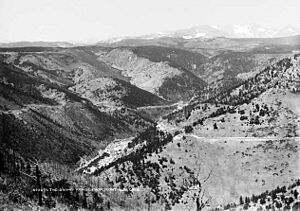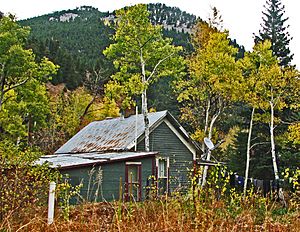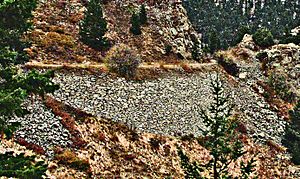Switzerland Trail facts for kids
The Switzerland Trail is a famous old railroad path in Colorado. It was once a 3 ft (914 mm) narrow gauge railroad line. This means the tracks were closer together than regular train tracks. Different companies ran trains here around the year 1900. These companies included the Greeley, Salt Lake and Pacific Railway, the Colorado and Northwestern Railroad, and the Denver, Boulder, and Western Railroad.
The trail is located in the Colorado mountains, near old mining towns like Nederland, Gold Hill, and Ward. The western part of the trail is so important that it's listed on the National Register of Historic Places. This means it's a special place protected for its history.
Contents
History of the Switzerland Trail
The first part of this railroad was built in 1883. Tracks kept growing until 1894. Then, a big flood washed away many tracks, and the company running it went out of business.
In 1896, a new company called the Colorado and Northwestern (C&N) took over. They fixed the tracks and added more lines. The C&N gave the railroad its famous name, "Switzerland Trail," in 1898. They hoped this name would attract more tourists because the area looked like the beautiful mountains of Switzerland.
By the late 1800s, the C&N also stopped operating. The Denver, Boulder, and Western (DB&W) company then took over the line. However, in 1919, the railroad was finally shut down. All the train tracks were removed, but the path where they used to be still remains.
What is the Trail Like Today?
Today, a large part of the old railroad path is used as a hiking and biking trail. It's part of the Boulder County road system. People love it because it offers amazing views of the Front Range mountains.
The mountain route is about 30 miles long. It winds through altitudes from 7,000 to over 9,000 feet high. The trail goes from the old townsite of Eldora, Colorado, past Nederland, and then north through Sugar Loaf and all the way to Ward.
The path passes by several historic mines. These include the Blue Bird Mine and areas near the Caribou Mine. The Caribou Mine was in the once-busy, now ghost town of Caribou. The main railroad line originally started in Boulder, Colorado. It went up Fourmile Canyon through mining towns like Salina, Colorado and Crisman, Colorado. It was even connected to Denver, Colorado using special tracks.
Life Along the Trail in the Past
Around the year 1900, the Switzerland Trail was very important. It was the main way to move goods and people in the area. Trains carried supplies and tourists to mining camps and towns. They also moved ore from the many mines to processing mills. Then, the refined metal was taken down to Boulder to be sent across the country.
A special office for testing ore was built around 1900. It was near the quiet community of Wall Street, Colorado. This office, called the James F. Bailey Assay Office Museum, is still there today. It's a bit of a curiosity because Wall Street is now a small group of houses far from any big town.
The C&N and DB&W railroad companies were smart. They made good money by bringing tourists from Boulder and Denver up into the mountains. The railroad even helped build special park sites and hotels. One example is the Mont Alto park site, which is now marked by a sign. These places were made to attract people for day trips.
Why the Railroad Closed
The Switzerland Trail eventually closed for several reasons:
- Harsh Winters: The Rocky Mountains have very tough winters. This limited tourist travel to only about four months a year. It also often forced the train line to close and sometimes even caused harm to train crews.
- New Inventions: The invention and popularity of cars meant fewer people needed trains.
- Mine Closures: Some mines in Ward and Eldora closed down. This meant less ore to transport.
- Failed Projects: Some big projects, like a long tunnel meant to reach rich gold areas, did not work out.
The Trail Today for Fun
The Switzerland Trail is still very popular today. People use it for hiking, riding ATVs, motorcycles, 4x4 vehicles, and biking. The old railway path is smooth and has a gentle slope. This makes it easy to travel. The path is also narrow, usually about 8 to 10 feet wide. This brings users very close to the amazing mountain scenery.




